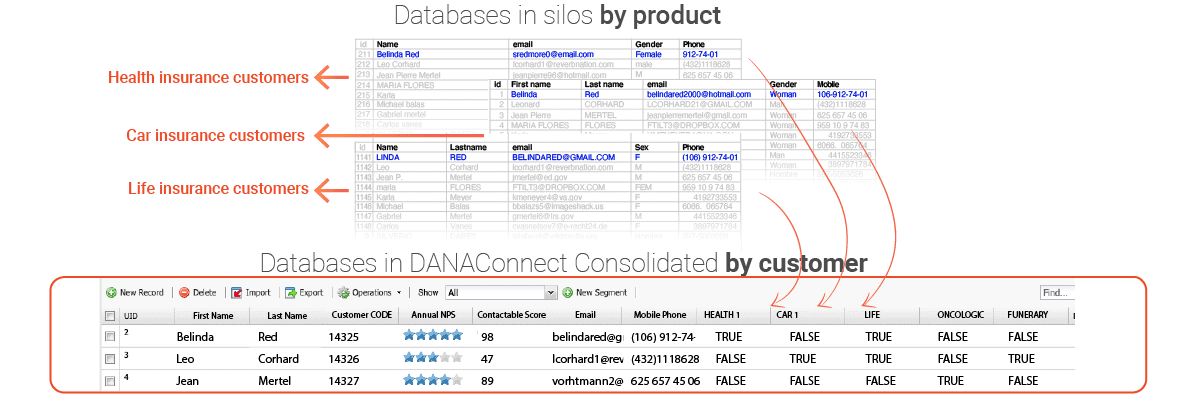Customer centric data model for Insurance

What is a Customer centric data model for Insurance?
A customer-centric data model provides the basis for storing data in a way that makes it possible to track the evolution of customers and automate processes in order to offer the most personalized experience possible, as well as enable the mainstreaming of the information within the organization, keeping the customer’s contact master data updated and centralized in a single repository.
Would you like a personalized presentation of this service?
Objectives:
- Consolidate customer contact information into a single database so they can be accessed and used by all departments and kept up-to-date.
- Improve the company’s ability to reach customers by improving the quality and reliability of contactability data.
- Ensure the management and governance of communication with clients.
Enhance the customer experience by allowing the flow of data between different digital channels and different departments. - Have the basis for indexing a digital document repository associated with the client’s dossier or file (identity documents, passports, records, etc.)
Solution:
Unification of customer data that currently is, separated, diparated and multiplied by each insurance product, in a single centralized database to facilitate the access, consultation and updatin of said data to improve processes.
Customization possibilities:
- Data model customization to support all your types of customers, products, and customer-agent relationships.
- Segment creation.
- Formatting and normalization of the texts in the fields.
- Email validation and removal of spamtraps
Implementation timeframe:
- 2 to 4 weeks
Pre requirements:
- Have a DANAconnect account
- Provide the data from the different databases to unify
Would you like a personalized presentation of this service?
How Building a Customer-Centric Data Model Can Help Your Business Grow
Business growth is one of the most important things a company can strive for. The key to achieving this goal is understanding your customers and their needs. By building a customer-centric data model, you can gain insight into how to best target your customers and provide the services that will be most beneficial to them. This model is designed to help you maximize your customer base, as it provides you with an actionable plan based on data-driven insights. With the right data model in place, you can build a stronger connection with your customers and develop a strong foundation for growth. By taking the time to build a customer-centric data model, you can ensure that your business is ready to take advantage of any opportunities that come its way.
What is a Customer-Centric Data Model?
A customer-centric data model is a strategic approach to building a strong business. This model focuses on the customer experience and the data that has the potential to help marketers understand their needs and interests. When you have a strong understanding of your customers, you can better meet their needs and create a positive customer experience. As a result, you are more likely to retain your current customers and attract new ones. Customers are essential to the success of any business, and a customer-centric approach to data modeling can help you optimize your efforts toward them. When you create a customer-centric data model, you are focusing on your most important asset: your customers. It’s important to not just collect data that is helpful for marketing purposes, but also focus on building a strong relationship with your customers. When you understand your customers’ needs and interests, you can create a better experience for them and increase their loyalty. Building a customer-centric data model focuses on collecting data that will help you connect with customers. This type of data model is designed to help you maximize your growth potential and better understand your customers so you can offer them the best experience possible.
Benefits of Building a Customer-Centric Data Model
When you build a customer-centric data model, you will have a better understanding of how to target your customers and provide them with the best service possible. This model can help you achieve several benefits, including:
- Better Customer Engagement: A customer-centric data model will help you better understand your customers’ needs and interests so you can create a better customer experience. With this model in place, you will have an actionable plan to create meaningful connections with your customers like for instance cross selling segments. This can result in increased customer loyalty and a higher rate of repeat business.
- Stronger Customer Relationships: A customer-centric data model can help create stronger customer relationships. With this model, you have the chance to build a relationship based on trust, which will help you create lifelong customers.
- More Effective Marketing: A customer-centric data model can help you better understand your customers so you can create more effective marketing campaigns and campaigns that resonate with the right audience. With the right data, you can create more personalized marketing campaigns that will be more effective.
- Increased Revenue: A customer-centric data model can help you better understand your customers so you can create more effective marketing campaigns. This can result in increased revenue, which can lead to more capital for the business.
Steps to Building a Customer-Centric Data Model
When building a customer-centric data model, there are a few steps you should take to ensure success. Here are some steps you can take to begin building a customer-centric data model:
- Identify Your Key Metrics: The first step to building a customer-centric data model is to identify your key metrics. These metrics can be used to guide your entire data model and provide insight into what data is most important for your business.
- Create Customer Segments: Once you have created your key metrics, you can begin to create customer segments based on the data collected. Customer segments are designed to help you better understand your customers and create meaningful connections with them.
- Develop a Data-Driven Plan of Action: Once you have created your customer segments, you should develop a data-driven plan of action, which includes executing your marketing strategy based on the data collected.
- Implement Your Data Model: Once you have developed your data model, you can implement it to help you better understand your customers and create stronger connections with them.
- Measuring the Impact of Your Data Model: Finally, you should measure the impact of your data model to help you understand how effective it is in helping you achieve your business goals.
Conclusion
A customer-centric data model can help any business grow. This model is designed to help you better understand your customers so you can create meaningful connections with them and provide them with the best experience possible. Building a customer-centric data model can take some time, but the results are well worth it. When you have a data model in place, you can better understand your customers and create a stronger connection with them. Customers are essential to the success of any business, and a customer-centric approach to data modeling can help you optimize your efforts toward them.

